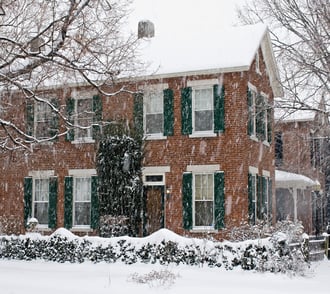Owners of historic brick homes are often reminded to pay close attention to their exterior brick walls. Routine inspections and tuckpointing help ensure water doesn’t find its way into small cracks and gaps, which can lead to significant damage over time. But water on the above-ground bricks isn’t the only concern. With the spring thaw, large amounts of water can sit against your below-grade foundation walls, increasing the risk of dampness, cracks and leaks. Thankfully, proper grading around your historic brick home can help prevent this from happening.
What Does Grading Around the House Mean?
Grading around a house simply means sloping the ground away from its foundation. When your historic brick home was first built all those years ago, a hole for the foundation was excavated. Once the foundation and exterior were finished, the remaining space was backfilled with dirt. This dirt was loosely packed to prevent unnecessary pressure on the foundation walls. Over time, your house settled, and exterior factors, like heavy snow and freeze-thaw cycles, resulted in a flattened grade, or even one that slopes toward the house. This lack of proper grade, or slope, allows water to collect near your foundation, which in turn cause moisture and water problems in your below-grade spaces.
How Does Proper Grading Protect My Historic Brick Home?
Proper grading helps prevent excessively damp basements, leaks and cracks by ensuring water drains away from the foundation. Additionally, it relieves undue pressure on your foundation. Over time, this undue pressure can shift bricks out of place, leading to unstable, bulging walls. Living in D.C.’s variable climate means some of that below-grade water is subjected to the freeze-thaw cycle. When it’s above freezing, the water will be against the foundation, potentially working its way into small cracks. When the temperature dips below freezing, the water turns to ice and expands. This expansion puts extra pressure on the foundation walls, causes existing cracks to expand, and can create new cracks. Once temperatures rise, the ice turns back into water, finding more ways to get into your basement.
Do I Need to Grade if I Already Have Downspouts?
Yes. While gutters and downspouts direct rapid water accumulation, like rain, away from your historic brick home, slower-moving water, like a spring thaw, will still settle around your foundation without proper grading. Your downspouts should have extensions to move water as far from your home as possible. Downspouts that empty directly against the foundation only make the potential for water problems worse. Ideally, extensions should extend six feet away from your foundation. If this is not possible, a minimum of four feet is recommended.
How Do I Know if There are Existing Water Problems Around My Foundation?
Signs of water problems can be found inside and outside your historic brick home. On the exterior, you’ll want to look for puddling or pooling water, ground that is flat or sloped toward your home, and damage to above-grade brick and mortar, such as gaps, cracks or crumbling. There may also be dark patches of brick where water has saturated the wall. Inside, you’ll want to pay attention to musty smells, excessive dampness and water on the floor or walls. Mold, mildew and efflorescence are solid visual cues that can indicate something is amiss.
If you’re unsure about the state of your brick walls and foundation, consulting a local historic brick expert is a good idea. If they detect water concerns, they can direct you to the resources you need to solve the problem and provide tuckpointing services to ensure your historic brick home will be protected for decades to come. Contact us to arrange an inspection of your exterior brick, especially around the foundation of your home.
Tags:
Water damage, preventive maintenance, Preventing water damage, Water damage to Brick, Preventing Water Damage to Brick, Basement Water Damage, Brick Basement, Proper Grading, gutters, Grading around a House, Slope, downspoutsMar 21, 2024 8:30:00 AM


